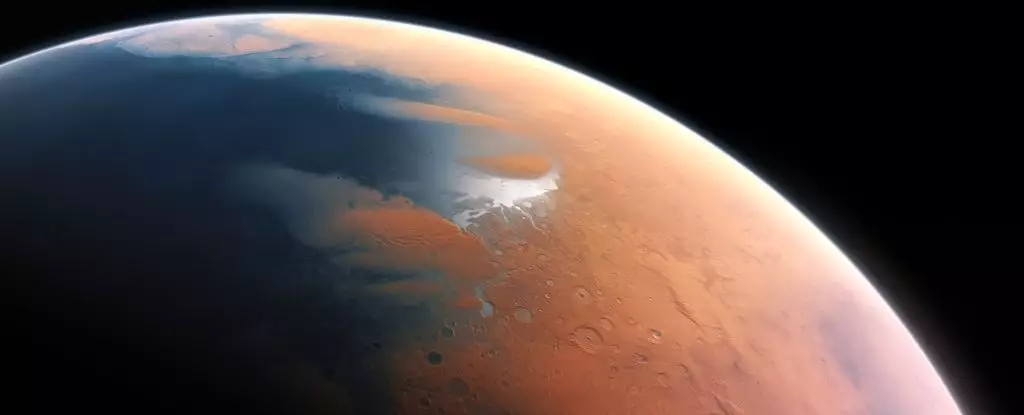The allure of Mars has captivated scientists and enthusiasts alike, primarily due to its stark landscape that hints at a transformative past. A recent wave of research delves into the enigmatic history of water on the Red Planet, revealing startling evidence that suggests Mars was not always the arid world we observe today. Ground-breaking studies, bolstered by the efforts of the Chinese National Space Administration’s Zhurong Mars rover, indicate that ancient oceans once roamed its surface, dramatically altering our comprehension of Martian geology and the potential for past life.
In a groundbreaking study, researchers employed sophisticated ground-penetrating radar (GPR) technology that allowed for an unprecedented view of Martian subsurface features. According to prominent geologist Benjamin Cardenas of The Pennsylvania State University, these investigations have uncovered signs reminiscent of ancient shorelines and beaches. This revelation prompts an intriguing hypothesis: that Mars once boasted a substantial body of liquid water—what researchers have named the Deuteronilus sea.
Arguments supporting the existence of such an ocean are compelling; features detected by the Zhurong rover reveal sedimentary structures consistent with terrestrial beaches and river deltas. This discovery indicates not just a transient presence of water, but rather a dynamic aquatic environment characterized by waves, wind, and sediment transport, evocative of the vacation-style beaches found on Earth. The implications are astounding: Mars was not merely a dusty rock, but a vibrant world bustling with hydrological activity.
One of the most challenging questions surrounding Mars is the water cycle that once thrived on the planet. While the surface now presents a dry façade, the evidence suggests otherwise. Dr. Michael Manga, a geophysicist from the University of California, Berkeley, underscores the significance of oceans for planetary climates, noting their role in shaping surfaces and fostering potential habitats for life. Critics and skeptics alike can no longer dismiss the notion that liquid water—once in abundance—flowed freely across Mars’ terrain.
What’s particularly noteworthy is the clarity with which researchers have been able to depict Martian aquatic landscapes through GPR. Measurements have probed layers of rock beneath the surface, revealing features that tilt towards what appears to be former shorelines at angles similar to those on Earth. This revelation fosters a deeper inquiry into not merely the existence of ancient water but the conditions that facilitated its presence for potentially millions of years.
Understanding Mars’ climatic and environmental past is vital not only to comprehending planetary evolution but also to guiding future explorations aimed at identifying possible life. The coastal environments that once existed on Mars may very well have been habitats suitable for primitive organisms, akin to the origins of life on Earth. As highlighted by Dr. Manga, the interface between land, water, and atmosphere constitutes a cradle for potential life. Therefore, identifying these prime locations becomes critical for directing future Martian missions and ensuring that they align with the pursuit of discovering ancient life forms.
While detailed studies have illuminated the planet’s watery past, a caveat remains: the fate of much of the Martian water is still shrouded in mystery. Some theories posit that vast reservoirs of liquid water might hide beneath the planet’s surface. Identifying and understanding these potential reserves could yield invaluable insights into Mars’ climatic history and its transition towards the dry environment observable today.
Despite the overwhelming evidence supporting the existence of ancient oceans, more questions arise. What precisely happened to the water? How did it vanish from the surface? These inquiries form the nucleus of ongoing scientific thought and research. The allure of Mars lies not just in confirming its historical water-rich past, but also in deciphering its future trajectory—particularly how it can inform our understanding of climate change and planetary transformations.
With modern technology in hand, scientists stand at the forefront of a remarkable era of exploration. The next phase will necessitate further investigation into Martian geology, focused on refining our models of liquid oceans and their implications for life. The quest for knowledge about our celestial neighbor continues, promising to bridge gaps between the past, present, and future of our planetary system. As we push towards understanding the mysteries that lie beneath the Martian surface, we find ourselves drawn closer to the ultimate question: could we one day uncover remnants of life in those ancient and forgotten oceans?


Leave a Reply